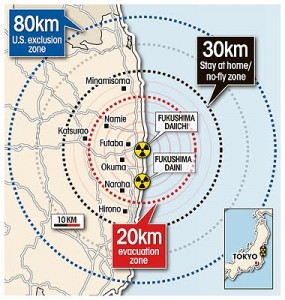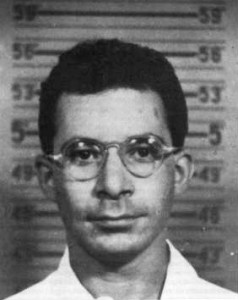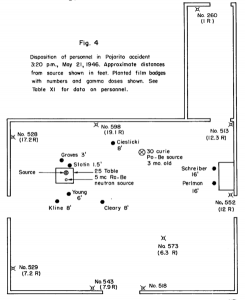Avoiding the harmful effects of radiation
You will have seen in the “Inverse-square” remote experiment that the amount of radiation received from a radioactive source decreases quickly the further you are away. In fact the rate of decrease has a particular form called Inverse-square.
“Inverse-square” means that if you double the distance away, the amount of radiation is decreased by a factor of four (since 4 is 2 squared). “Inverse” means it decreases with distance (rather than increases), and “square” means it decreases by the square of the amount the distance increases!

Map of exclusion and evacuation zones after the Fukushima nuclear accident. Distance from the source is the best way to avoid radiation poisoning.
What would happen if you tripled the distance?
Below are some real-life examples.
Fukushima Daiichi
You might have heard about the Fukushima nuclear power accident in the news a few years ago. The Fukushima Daiichi nuclear accident occurred on the 12th of March 2011 in Japan. It was caused by a very large earthquake followed by a tsunami. The damage caused by the tsunami produced equipment failures that led to a nuclear meltdown and the release of radioactive material. Just like in Chernobyl, evacuation was necessary and an exclusion zone was set up to keep people a safe distance away.
Because of the way radiation intensity decreases with distance, creating an exclusion zone is a very effective way of minimising harm to the population.
Here is a recent news report on the Fukushima nuclear distaster.
The Louis Slotin Incident
In 1946, to demonstrate to his colleagues how to initiate a nuclear reaction, Canadian physicist Louis Slotin placed two half spheres of Beryllium around a Plutonium core and held them apart with a screwdriver. As he was explaining that: “as long I keep the spheres apart, the reaction will not occur”, the screwdriver slipped and the spheres came in contact! The neutron reflecting Beryllium concentrated the neutrons emitted by the Plutonium core, initiating a fusion reaction. Tragically, the same Plutonium sphere had killed a close colleague only a year earlier.
Slotin died nine days after the accident after a series of agonising symptoms including massive blisters, intestinal paralysis and “a total disintegration of bodily functions”.
The three people closest to Slotin, Graves, Cieslicki and Young, died of a heart attack, leukaemia and bone marrow disease over the next 30 years. All of those deaths could be linked to the acute radiation poisoning they received that day.
Those standing further away from the “experiment”, such as Schreiber and Perlman standing by the door, received much less radiation than those at the front. Being three times further away meant they actually received 9 times less radiation, which made the difference between surviving and not surviving.






